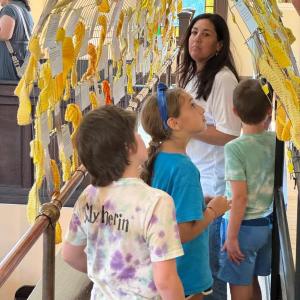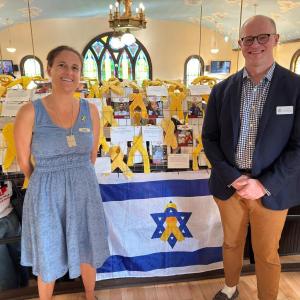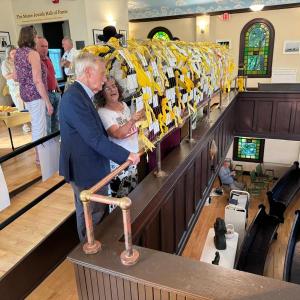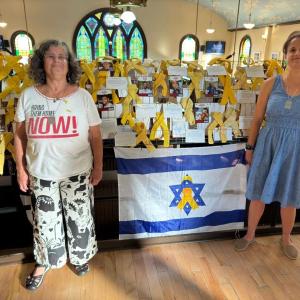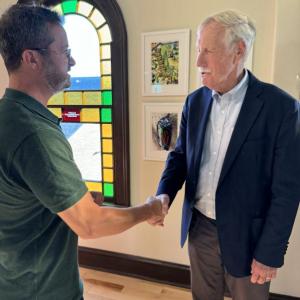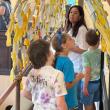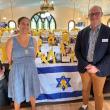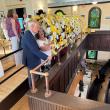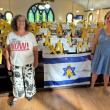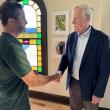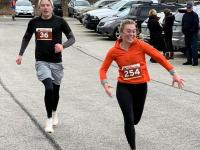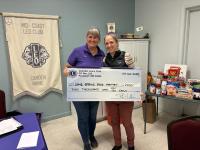‘Yellow Ribbon Exhibition for Our Loved Ones Held Hostage’ continues at Maine Jewish museum in Portland through Oct. 7
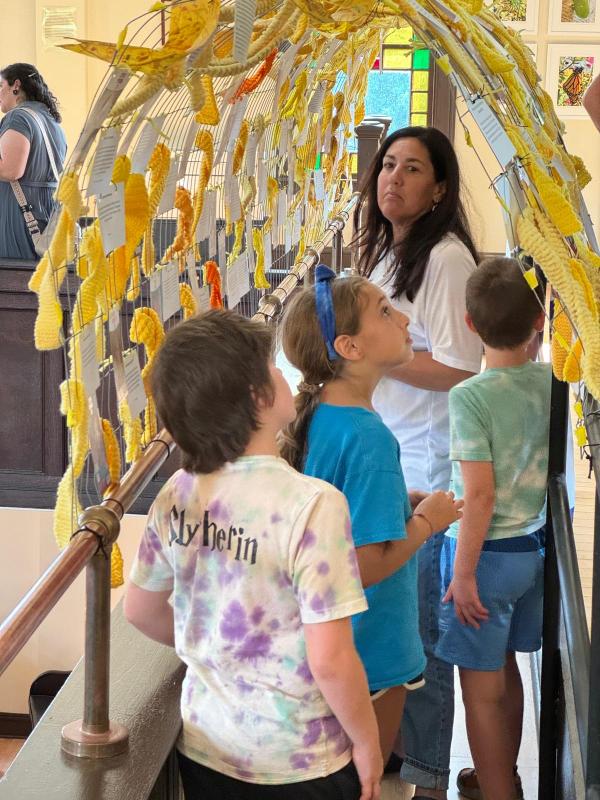 Children viewing the exhibit at the Jewish Museum in Portland Aug. 1. (Photo courtesy Jordan Cohen)
Children viewing the exhibit at the Jewish Museum in Portland Aug. 1. (Photo courtesy Jordan Cohen)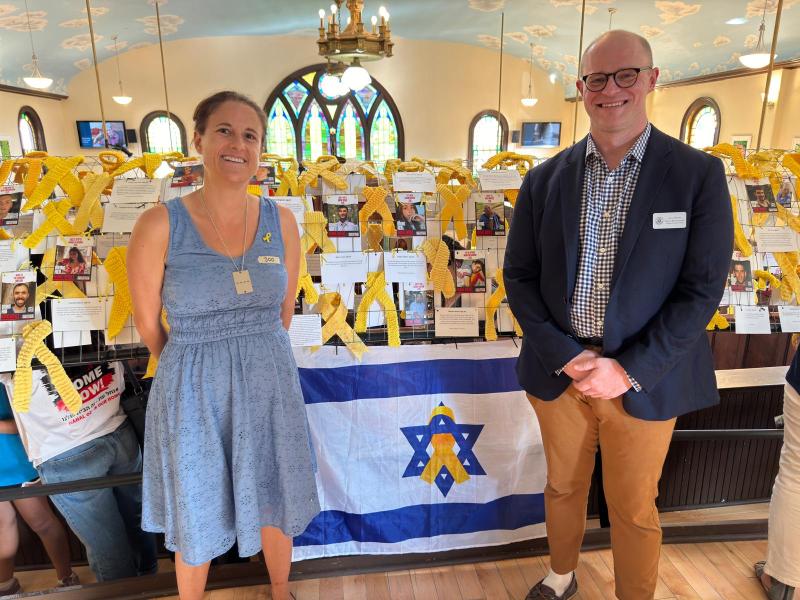 Exhibit organizer Anya Davidson with Scott Dresser, District Representative for U.S. Representative Jared Golden. (Photo courtesy Jordan Cohen)
Exhibit organizer Anya Davidson with Scott Dresser, District Representative for U.S. Representative Jared Golden. (Photo courtesy Jordan Cohen)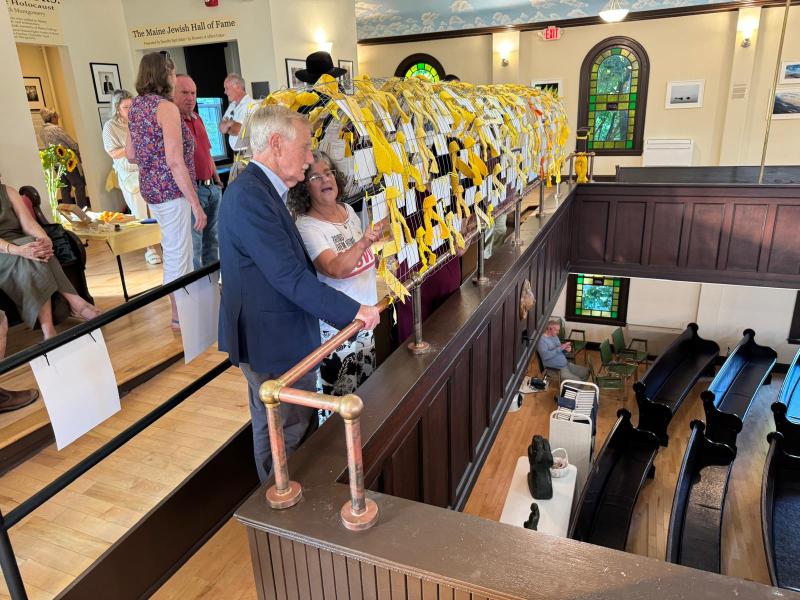 Maine Senator Angus King tours the exhibit with Camille Davidson. (Photo courtesy Jordan Cohen)
Maine Senator Angus King tours the exhibit with Camille Davidson. (Photo courtesy Jordan Cohen)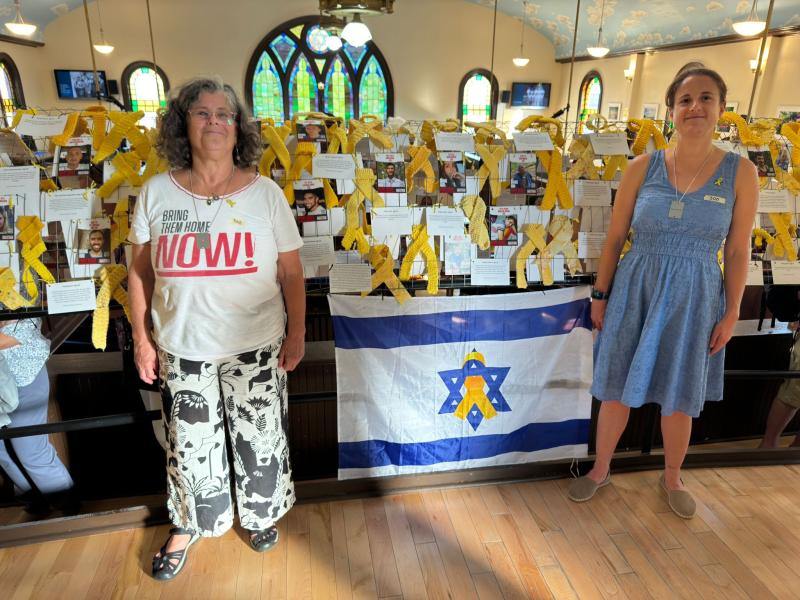 Organizers Camille and Anya Davidson (Photo courtesy Jordan Cohen)
Organizers Camille and Anya Davidson (Photo courtesy Jordan Cohen)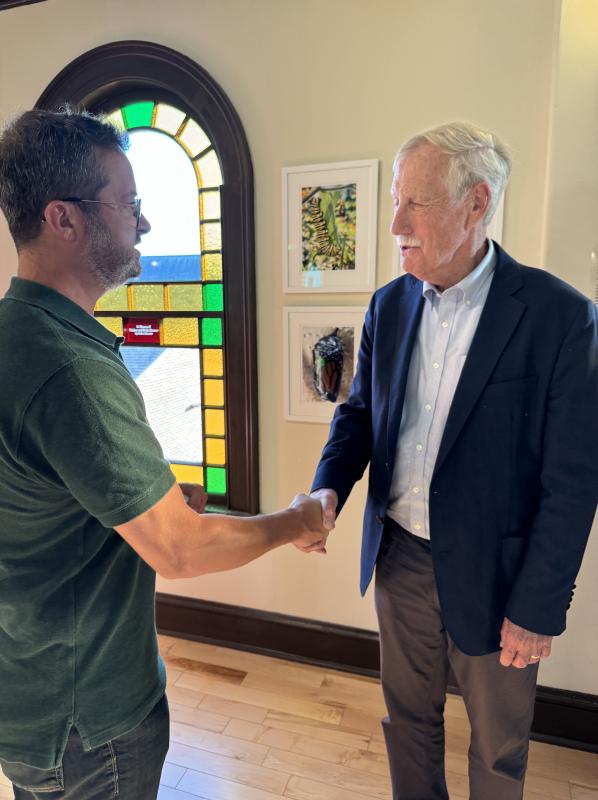 Camden resident Jordan Cohen greets Maine Senator Angus King. (Photo courtesy Jordan Cohen)
Camden resident Jordan Cohen greets Maine Senator Angus King. (Photo courtesy Jordan Cohen)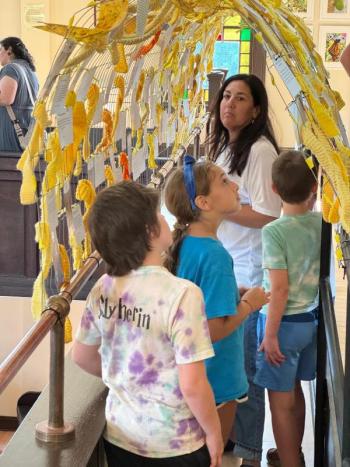 Children viewing the exhibit at the Jewish Museum in Portland Aug. 1. (Photo courtesy Jordan Cohen)
Children viewing the exhibit at the Jewish Museum in Portland Aug. 1. (Photo courtesy Jordan Cohen)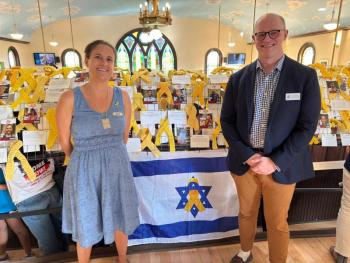 Exhibit organizer Anya Davidson with Scott Dresser, District Representative for U.S. Representative Jared Golden. (Photo courtesy Jordan Cohen)
Exhibit organizer Anya Davidson with Scott Dresser, District Representative for U.S. Representative Jared Golden. (Photo courtesy Jordan Cohen)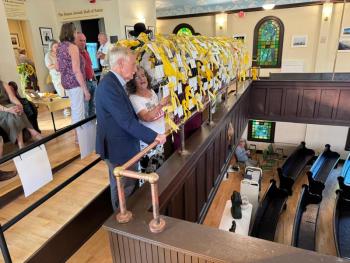 Maine Senator Angus King tours the exhibit with Camille Davidson. (Photo courtesy Jordan Cohen)
Maine Senator Angus King tours the exhibit with Camille Davidson. (Photo courtesy Jordan Cohen)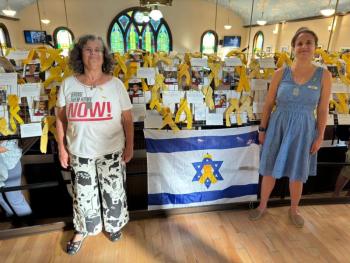 Organizers Camille and Anya Davidson (Photo courtesy Jordan Cohen)
Organizers Camille and Anya Davidson (Photo courtesy Jordan Cohen)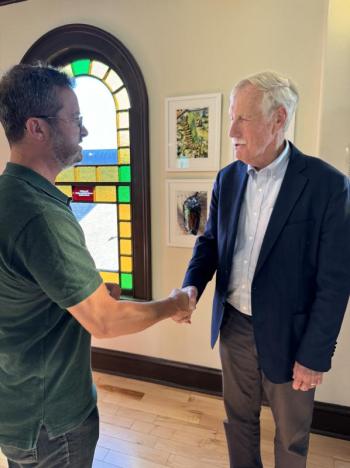 Camden resident Jordan Cohen greets Maine Senator Angus King. (Photo courtesy Jordan Cohen)
Camden resident Jordan Cohen greets Maine Senator Angus King. (Photo courtesy Jordan Cohen)Midcoast residents traveled to Portland last week to participate in the Yellow Ribbon Exhibition for Our Loved Ones Held Hostage, which runs through Oct. 7 at the Maine Jewish Museum in Portland.
The opening was held Aug. 1, which was 300 days since the October 7 terrorist attack on Israel by Hamas, Islamic Jihad, and other attackers.
Curated by mother-daughter duo Camille and Anya Davidson, the exhibition features yellow ribbons hand-stitched by Maine residents in solidarity with the 116 innocent civilians still held hostage in Gaza.
Approximately 20 Israeli and Jewish women in Maine stitched ribbons that were contributed to the exhibit.
The installation is set up tunnel-style to symbolize the underground tunnels where many hostages are held captive. Visitors are encouraged to walk through the tunnel to view the ribbons, along with the names and photos of the hostages each ribbon represents.
“’Stich Them Home’ is, at its essence, a community effort to keep the hostages and their loved ones top of mind, and a visceral plea to do everything in our power to bring them all home now,” the museum said, at its website.
One hundred fifteen hostages from Israel and 20 other nations, including eight American citizens are still being held in Gaza. The youngest hostage, Kfir Bibas, now 1.5 years old.
Doron Steinbrecher, 31, who was taken from kibbutz Kfar Aza. One-quarter of Kfar Aza's residents were murdered on Oct. 7.
“All of the surviving residents have been living in temporary housing constructed at Kibbutz Shefayim, where one of my cousin's lives, and have been there since the immediate aftermath of Oct. 7,” said Jordan Cohen, of Camden.
Thank you all for coming tonight. It means so much to have you here supporting this exhibition. My name is Anya Mae Davidson and together with my mother, Camille Davidson, and the help of others, we created this installation in honor of the hostages that remain in Gaza.
My mother and I are dual citizens of both Israel and the United States and also mothers. While everyone has felt the pain of Oct. 7, we wonder if anyone has felt it as deeply as the mothers. The mothers of the hostages have been fierce advocates for the release of their children. Rachel Goldberg Polin, an American Israeli, has used her voice to travel the world speaking about her 23 year old son Hersh. Hersh was kidnapped from the Nova Music Festival on Oct.7. He was taken after his dominant arm was blown off from the elbow down by a grenade thrown into the shelter where he was hiding. It was Rachel who started the practice of wearing masking tape over her heart with the number of days since Oct. 7 or in her words “since her son was stolen from her”. She encourages others to do the same and you can see that we have done so tonight.
Today marks 300 days since that tragic day. None of us could have imagined that we would be in this place 300 days later. 115 people are still held hostage, many of whom we don’t even know if they are alive or dead. It’s been a long and heartbreaking 10 months, full of devastation. The loss of life of so many innocent civilians is inconceivable.
One of the core tenets of the Jewish faith is the act of bearing witness. Bearing witness can be done in multiple ways but it is supposed to be done actively. We are to engage, listen and respond in meaningful ways and not sit idly by. Today we are all bearing witness by recounting some of the stories of October 7. Through the stories of the hostages we preserve not only their memory but also their dignity. This small act gives them a voice when they have none.
The yellow ribbon has become a symbol to demand the release of the hostages, often in the form of a pin that many wear daily. These ribbons here were crafted with care and intention by many different community members, young and old, Jewish and non Jewish.
They are randomly placed on the fencing with a picture of almost every one of the remaining hostages. There is also a write-up of what we know happened to them on that dark day. You will see two orange ribbons which represent the two youngest hostages. These are the redheaded Bibas brothers; Ariel, who will turn 5 in a few days and Kfir, who marked his first birthday in January, as a hostage.
The idea of knitted or crocheted ribbons was not my own but from a community project called “Stitch them home” by fiber artist Sarah Divi along with the “Beautifully Jewish” group from the Tablet magazine. The patterns and instructions for people to create their own installations in their respective communities are available online for anyone to use. However, after we gathered all the ribbons together the project began to change into something different. We realized that a yellow ribbon may symbolize a hostage to us but to someone else it doesn’t give any context. Our hope is that as you read about them and see their faces, you are able to understand that these are people just like you or me, their families could have been our families.
The tunnel serves not only as a representation of the tunnels in Gaza where the hostages may be hidden but is also meant to portray the all encompassing suffering of the hostages and their families. As you stand under the pictures and read their stories you will see that this pain is not unique to the Israelis or the Jews. Among the hostages, over 20 different countries are represented along with several religions. In fact,Thailand, next to Israel, suffered the most losses on Oct. 7. Hamas inflicted devastation on whoever they came into contact with that day, regardless of their religion or nationality. There remain 8 American citizens in captivity, so regardless of our personal connection to Israel and as Jews, we as Americans have the obligation to advocate for the release of ALL the hostages.
Thanks to Dawn LaRochelle, Director of the Maine Jewish Museum, who supported this exhibit from the idea phase and letting us use this beautiful
space. Displaying the tunnel here, situated between the Holocaust exhibit and the benches where women once gathered in the synagogue, is profoundly symbolic. It serves as a poignant reminder of the most devastating event for the Jewish people since the Holocaust. The benches nearby represent the mothers who would move mountains to bring their children home. We believe that if women, more specifically mothers, were at the negotiating tables, a deal for the return of the hostages and a ceasefire would have been reached long ago.
In conclusion, if you take one message from tonight, please let it be to tell the stories of the hostages and not let them be forgotten. As Rachel says to her son Hersh, may we say it today and everyday after to all the hostages until they are returned: “I love you, stay strong, survive”.

